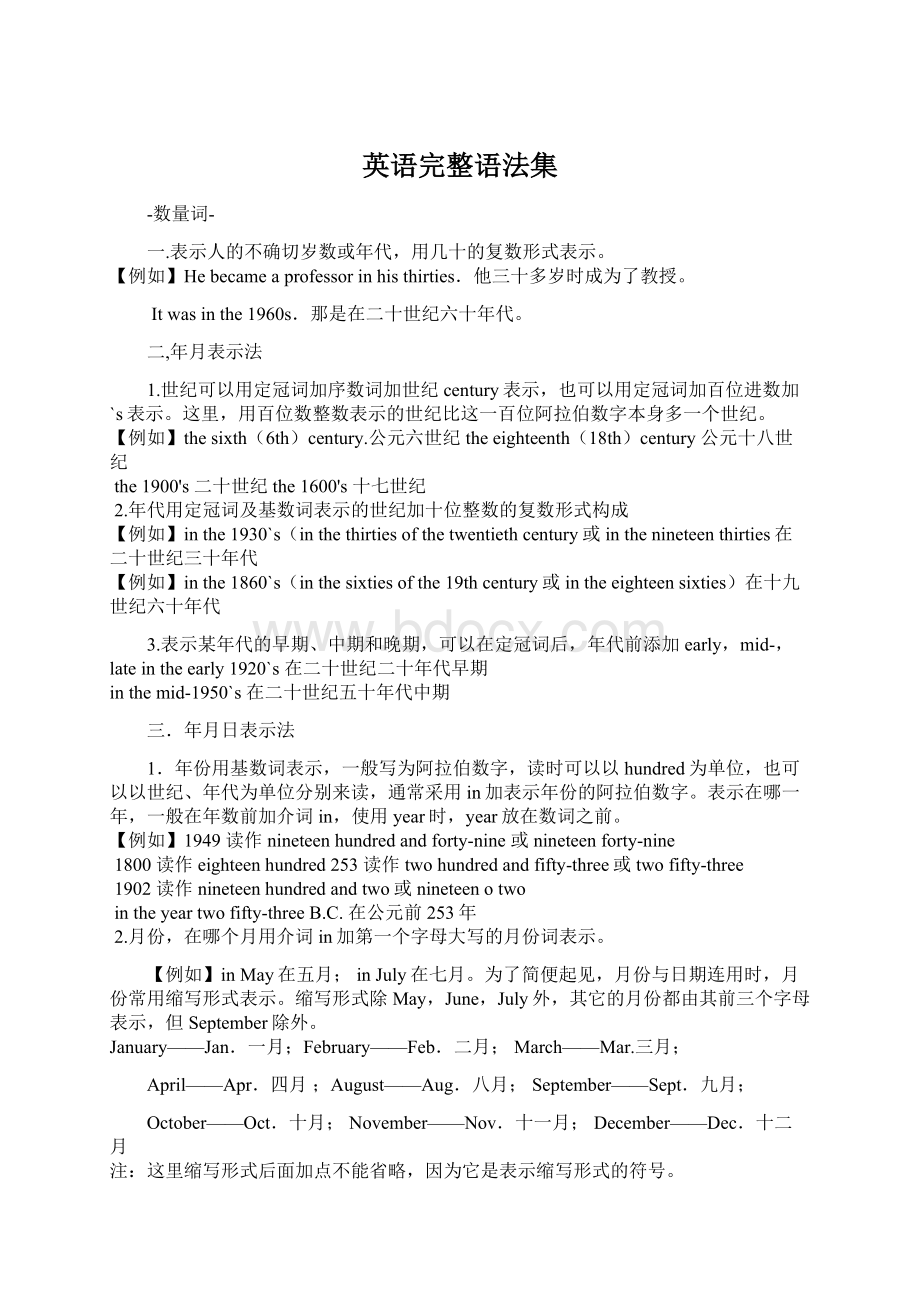 英语完整语法集.docx
英语完整语法集.docx
- 文档编号:8299823
- 上传时间:2023-01-30
- 格式:DOCX
- 页数:55
- 大小:83.63KB
英语完整语法集.docx
《英语完整语法集.docx》由会员分享,可在线阅读,更多相关《英语完整语法集.docx(55页珍藏版)》请在冰豆网上搜索。

英语完整语法集
-数量词-
一.表示人的不确切岁数或年代,用几十的复数形式表示。
【例如】Hebecameaprofessorinhisthirties.他三十多岁时成为了教授。
Itwasinthe1960s.那是在二十世纪六十年代。
二,年月表示法
1.世纪可以用定冠词加序数词加世纪century表示,也可以用定冠词加百位进数加`s表示。
这里,用百位数整数表示的世纪比这一百位阿拉伯数字本身多一个世纪。
【例如】thesixth(6th)century.公元六世纪theeighteenth(18th)century公元十八世纪
the1900's二十世纪the1600's十七世纪
2.年代用定冠词及基数词表示的世纪加十位整数的复数形式构成
【例如】inthe1930`s(inthethirtiesofthetwentiethcentury或inthenineteenthirties在二十世纪三十年代
【例如】inthe1860`s(inthesixtiesofthe19thcentury或intheeighteensixties)在十九世纪六十年代
3.表示某年代的早期、中期和晚期,可以在定冠词后,年代前添加early,mid-,lateintheearly1920`s在二十世纪二十年代早期
inthemid-1950`s在二十世纪五十年代中期
三.年月日表示法
1.年份用基数词表示,一般写为阿拉伯数字,读时可以以hundred为单位,也可以以世纪、年代为单位分别来读,通常采用in加表示年份的阿拉伯数字。
表示在哪一年,一般在年数前加介词in,使用year时,year放在数词之前。
【例如】1949读作nineteenhundredandforty-nine或nineteenforty-nine
1800读作eighteenhundred253读作twohundredandfifty-three或twofifty-three
1902读作nineteenhundredandtwo或nineteenotwo
intheyeartwofifty-threeB.C.在公元前253年
2.月份,在哪个月用介词in加第一个字母大写的月份词表示。
【例如】inMay在五月;inJuly在七月。
为了简便起见,月份与日期连用时,月份常用缩写形式表示。
缩写形式除May,June,July外,其它的月份都由其前三个字母表示,但September除外。
January——Jan.一月;February——Feb.二月;March——Mar.三月;
April——Apr.四月;August——Aug.八月;September——Sept.九月;
October——Oct.十月;November——Nov.十一月;December——Dec.十二月
注:
这里缩写形式后面加点不能省略,因为它是表示缩写形式的符号。
3.日期用定冠词the加序数词表示。
在哪一天要添加介词on
【例如】NationalDayisonOct.1.=NationalDayisonthe1stofOctober.国庆节是十月一日。
(读作Octoberfirst)
May5=thefifth(5th)ofMay五月五日(读作Mayfifth)
Mar.1(st)三月一日(读作Marchfirst或thefirstofMarch)
四.量词特点
在英语中,有很多量词词组,例如:
agroupof,aflockof,abunchof,abundleof等等。
量词词组有以下的特点,具体表现为:
特点一:
英语量词词组所表示的数或量,大致可归纳为四种类型,即定量、不定量、大量和少量。
1.表示定量的量词词组,譬如:
acoupleof(两个、一对)—acoupleofdays,acoupleofplayers,acoupleoftimes
acupfulof(一满杯)—acupfulofjelly,acupfulofwater
aportionof(一份/客)—aportionofduck,aportionofroastbeef
2.表示不定量的量词词组,譬如:
amajorityof(大多数/大半)—amajorityofopinions,amajorityofvotes
anatomof(一点)—anatomoffood,anatomoftruth
aspellof(一阵/一段时间)—aspelloffineweather,aspellofcoughing
3.表示大量的量词词组,譬如:
afloodof—afloodofink(洋洋大篇),afloodoftears(泪如泉涌)
aheapof—aheapofearth(一堆泥土),aheapofcustomers(许多顾客)
amountainof—amountainofdebts(债台高筑),amountainofdifficulties(困难重重)
4.表示少量的量词词组,譬如:
adropof—adropoffever(有点热度),adropofdew(一点露水)
aparticleof—aparticleoffeeling(一丝感情),aparticleofdust(一点灰尘)
ashadowof—ashadowofdoubt(一点怀疑),ashadowoffreedom(一点自由)
特点二:
有些数量词组修饰可数名词,有些数量词组修饰不可数名词,还有些则两者均可修饰。
1.修饰不可数名词的量词词组,譬如:
abitof—abitofEnglish(一点英语),abitofgoodadvice(一些好意见),abitofinterest(一点兴趣)
ashredof—ashredofevidence(一点证据),ashredofcloth(少量布),ashredofreputation(一点声誉)
asheetof—asheetofglass(一块玻璃),asheetofwater(一片汪洋)
2.修饰可数名词的量词词组,譬如:
aclusterof—aclusterofflowers(一簇花),aclusterofspectators(一群观众),aclusterofbrightstars(闪烁群星)
astringof—astringofpearls(一串珠子),astringofcurses(连续不断的咒骂),astringofexcuses(一连串借口)
ascramof—ascramofmosquitoes(一群蚊子),ascramofgeese(一群鹅),ascramofchildren(一群孩子)
3.修饰(不)可数名词的量词词组,譬如:
abodyof—abodyofbees(一群蜜蜂),abodyofcoldair(一股冷空气),abodyoffacts(许多事实)
ablockof—ablockofice(一大块冰),ablockofflats(一幢公寓),ablockofhouses(一排房子)
achainof—achainofideas(一系列想法),achainofaccidents(一连串事故),achainofproof(一连串证据)
特点三:
有些数量词组的搭配是固定的,而有些搭配则比较灵活。
1.搭配固定的量词词组,譬如:
abarrelof—abarrelofbeer(一桶啤酒),abarrelofcrudeoil(一桶原油)
abasketof—abasketofeggs(一篮鸡蛋),abasketofapples(一篮苹果)
alineof—alineoftrees(一行树),alineofpoetry(一行诗)
2.搭配较灵活的量词词组,譬如:
apieceof—apieceofpaper(一张纸),apieceoffurniture(一件家具),apieceofequipment(一台设备)
aroundof—aroundofspirit(一巡酒),aroundofdiplomatictalks(一轮外交谈判),aroundoftoast(一片烤面包)
abarof—abarofchocolate(一块巧克力),abarofsoap(一条肥皂),abaroflight(一束光)
-形容词和副词-
一.形容词
1.形容词的位置
单个形容词修饰名词的时候,一般前置。
但是下列情况下形容词却要后置。
1)当形容词修饰由some/no/any+thing/body/one构成的复合代词时,总是后置。
【例如】Ihavesomethingurgenttodo,soIhavetogonow.
Theremustbesomethingwrongwithhim.
2)以able或ible结尾的形容词与all,every,only或形容词最高级连用时。
【例如】Thesearethebestbooksavailableintheuniversitylibrary.
Parisisoneofthemostbeautifulcitiesimaginable.
3)形容词词组常后置。
【例如】Iknowagirlgoodatsinging.多个形容词修饰同一名词的顺序
4)几个形容词修饰同一名词时,词序无固定规律,一般顺序为:
1)限定词(冠词/代词/数词)→2)性质→3)大小/形状/新旧/年龄/颜色→4)名词性定语(包括动名词)→5)名词
【例如】Chinaisagreat,modernizedsocialistcountry.
Nancyisreadinganold,exciting,romanticlovestory.
Maryhasjustboughtherselfaprettygreencottondress.
MysisterknewatallintelligentyoungAmericanprofessorwhomshemetincollege.
2.作表语的形容词
1)很多以a开头的形容词,如asleep,afraid,awake,alone,aware,alive,ablaze,alike等,一般只作表语。
【例如】Hewassotiredthathesoonfellasleep.
Whetherhewasaliveordeadintheearthquakeisstillunknown.
2)这类形容词有时可以放在名词后作后置定语。
【例如】Heisoneofthepersonsaliveaftertheflood.
Theoldmanwastheonlypersonawakeatthemoment.
3)这类形容词中有些像alike(相同),alone(单独),amiss(差别),afire(燃烧着),adrift(漂流),afloat(漂浮),afoot(徒步)等既是表语形容词,又是副词,它们的用法不同。
【例如】Thetwinslooksomuchalikethatitisdifficulttodistinguishonefromtheother.
MybrotherandIalikearefunsofpopmusic.
4)一些表示身体健康情况的形容词,如ill,well,unwell,fit,poorly等,一般作表语。
【例如】Idon’tfeelwell,Ineedtogotoseethedoctor.
Howtokeepfitisapopulartopicthesedays.
二.副词
1.副词在句中的位置
1)修饰形容词或副词时,通常放在前面。
2)当句子的谓语动词是行为动词时,频度副词一般放在谓语动词之前。
句中有be或助动词、情态动词时,放在其后。
【例如】Ioftengotothecinemaonweekendwithmyhusband.
Icanhardlyunderstandhimforwhathesaidwasreallyconfusing.
Ihaveneverbeenabroaduntilnow.
3)程度副词修饰形容词或副词,通常放在被修饰的形容词之前。
但是enough总是放在所修饰的形容词或副词之后。
【例如】Theboydidn’tworkhardenough.
Heisquitediligent.Buthisachievementisnotgoodenough.
4)only的位置比较灵活,修饰哪个词,就放在哪个词的前面,以示强调。
【例如】IonlysawJohnyesterday.Ididn’tseehiswife.
Ihaveboughttwokilosofpotatoesonly.
Onlyintheafternoon,canyouborrowbooksfromtheuniversitylibrary.
5)onlytoopleasedtodosth:
非常想干某事
【例如】Ionlytoopleasedtogohome.
2.副词的作用与构成
1)副词用来修饰形容词、副词和动词。
大部分副词由“形容词+ly”构成,如:
happy→happily,slow→slowly,wonderful→wonderfully等。
但有些以ly结尾的词却不是形容词,而是副词,如:
friendly,brotherly,likely,lonely等。
有些词可以作形容词也可以作副词,如:
early,late,fast,hard,low,much,near等。
2)fairly,quite,rather表示“十分,非常”。
fairly语气最弱,放在不定冠词之后;quite语气较强,放在不定冠词之前;rather语气最强,可放在不定冠词前后,也可放在比较级前和too之前。
【例如】Thisisafairlyinterestingstory.Iwanttotellittomyfriends.
Youhavemadequiteafewmistakesinyouwriting.(quiteafew=many)
TheweatherisrathercoldertodaythanIhaveexpected.Thestudentwasrathertoodull.
3.具有两种形式的副词
英语中有的副词兼有两种形式:
一种是与形容词同形;另一种是在该形容词后面加副词词缀ly构成。
这两种形式的副词在词义和用法上有一定的差异,有的甚至完全不同。
常见的这类副词有:
firm稳固地firmly坚固地;direct径直地directly恰好;flat平淡地flatly直截了当地;short突然shortly不久;even甚至evenly平均地;clean完全地,径直地cleanly清洁地,干净利索地;clear隔开,不接触clearly清晰地,明显地;close近closely紧密地,接近地;easy安适地easily容易地;dead突然地,完全地deadly死一般地,非常;fair公平,正直地fairly相当地;right还好,适当地rightly改正地,合理地,正确地;just正好justly公正地;sharp突然地,急剧地sharply严厉地
【例句】Don’tcometooclose./Icloselyresemblemyfather.
Thetrainstoppeddead./Sheturneddeadlypale.
Sheslippedrighttothebottomoftheicymountain./Iamrightlyinformed.
三.比较级
1.比较级的修饰词
比较级可以用much,far,alot,agreatdeal,alittle,abit,byfar来修饰。
【例如】SheismuchmorebeautifulthanIhavethought.
ThesituationisfarmorecomplicatedthanIhaveimagined.
Icandoalittlebetterthanyou.Letmedoit.
2.形容词、副词比较级
1)比较的成分要对等。
【例如】Heismoreconcernedaboutothersthanabouthimself.
Myfatherisinbetterhealthnowthanlastyear.ThepopulationofChinaislargerthanthatofAmerica.
2)the+比较级……,the+比较级……意为“越……,越……”。
前面部分是从句,后面部分是主句。
【例如】Theharderyouwork,themoresuccessfulyouwillbe.
Theearlieryoucome,thebetterplaceyoucanfind
3.没有比较级的形容词和副词
1)有些程度副词,如:
quite,rather,comparatively,incomparably,relatively,fairly等与形容词连用具有“比较”含义。
故这时句中的形容词不能再使用比较级。
【例如】Itisasetofcomparativelynewinstrumentinourlaboratory.
Thisbookisratherdifficultforthejuniors,butfairlyeasyfortheseniors.
2)下列几类形容词也没有比较等级:
①表示“终极”意义或绝对概念的形容词或副词。
如:
absolute(ly),blind,dead,excellent,entire,living,full,perfect(ly),round,relative,wrong等。
②表示时间、方位或方向的形容词或副词。
如:
back,backward,forward,front,past,monthly,weekly,present,southern,vertical等。
③部分表示事物性质、物质材料或结构成分的形容词。
如:
atomic,cultural,economic,educational,golden,political,scientific,silken,urban,wooden等。
④本身具有“最”或“唯一”概念的形容词。
如:
maximal,mere,minimal,matchless,sole,onlyunique等。
4.不用than的比较
并不是所有的形容词表示比较时都用than,英语中有几个以-or结尾源于拉丁语的形容词,由于其原级已具有比较的含义,在表示比较时不用than,而用to。
这类形容词不多,计有:
anterior/priorto(先于),posteriorto(在……之后),superiorto(优于),inferiorto(劣于),juniorto(年幼于),seniorto(年长于)。
【例如】Thistaskispriortoallothers.
Hethinksheissuperiortohisclassmatesbecausehisfatherisaveryimportantpeople.
TheRedArmywasinferiorinequipmentbutsuperiorinmoraletotheenemy.
MyarrivalinBeijingisposteriortothatofourmanager.
Ithappenedpriortomyarrival.
Theofficial’srankisseniortohisfather’s.
Maryistwoyearsseniortome,andhersisterisjuniortomebythreeyears.
5.几个含有than的结构
1)nomorethan
只,仅仅,只不过是(=only),后面接名词或数词,在句中起形容词作用。
【例如】Thestreetisnomorethantwomileslong.这条大街只有两英里长。
Whatheissayingisnomorethanajoke.他所讲的只不过是个玩笑而已。
Theestimateof20012tonswasprobablynomorethananotherwildassumptionoftheirs.这个二万零一十二吨的估计数字,也许只不过是他们的又一个胡编乱造。
2)nomore...than(=not...anymorethan)和……一样不(not...anymorethan)。
Than前后都是否定的含义。
【例如】whaleisnomoreafishthanahorseis.(=Awhaleisnotafishanymorethanahorseis.)鲸和马都不是鱼。
(鲸之非鱼类,正如马之非鱼类。
)
MyelderbrotherisnomoreasingerthanIam.我哥哥和我都不是歌唱家。
Theywillnomoresellthei
- 配套讲稿:
如PPT文件的首页显示word图标,表示该PPT已包含配套word讲稿。双击word图标可打开word文档。
- 特殊限制:
部分文档作品中含有的国旗、国徽等图片,仅作为作品整体效果示例展示,禁止商用。设计者仅对作品中独创性部分享有著作权。
- 关 键 词:
- 英语 完整 语法
 冰豆网所有资源均是用户自行上传分享,仅供网友学习交流,未经上传用户书面授权,请勿作他用。
冰豆网所有资源均是用户自行上传分享,仅供网友学习交流,未经上传用户书面授权,请勿作他用。


 铝散热器项目年度预算报告.docx
铝散热器项目年度预算报告.docx
 (公开课)概率的基本性质.ppt
(公开课)概率的基本性质.ppt
